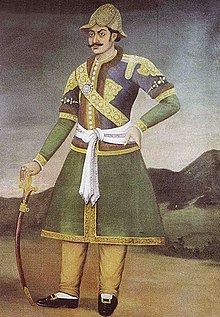Bhimsen Thapa
|
Shree Mukhtiyar General Bhimsen Thapa |
|
|---|---|
| श्री मुख्तियार जर्नेल भीमसेन थापा | |

Bhimsen Thapa, the Mukhtiyar (equivalent to Prime Minister) of Nepal from 1806 to 1837
|
|
| Mukhtiyar of Nepal | |
|
In office 1806–1837 |
|
| Monarch |
Girvan Yuddha Bikram Shah Deva Rajendra Bikram Shah |
| Preceded by |
Rana Bahadur Shah as Mukhtiyar |
| Succeeded by | Ranajang Pande |
| Commander-in-Chief | |
| Preceded by | Damodar Pandey |
| Succeeded by | Rana Jang Pandey |
| Personal details | |
| Born |
August 1775 Pipal Thok village, Gorkha district, Nepal |
| Died | 5 August 1839 (aged 64) Bhim-Mukteshowr, Kathmandu, Nepal |
| Nationality | Nepali |
| Relations | nephew Mathabarsingh Thapa, grandsonJung Bahadur Rana, niece Queen Tripurasundari of Nepal |
| Children | Lalita Devi Pande, Janak Kumari Pande, and Dirgha Kumari Pande |
| Mother | Satyarupa Maya |
| Father | Sanu Sardar Amar Singh Thapa |
| Religion | Hindu, Kshetri |
| Military service | |
| Allegiance |
|
| Service/branch | Nepal Army |
| Rank | Commander-in-Chief |
| Commands | Commander-in-Chief |
| Battles/wars | Anglo-Nepalese War |
Bhimsen Thapa (Nepali: ; August 1775 – 5 August 1839) was the mukhtiyar of Nepal (equivalent to prime minister) from 1806 to 1837.
Bhimsen rose to power by initially serving as a bodyguard and personal secretary of King Rana Bahadur Shah. Bhimsen had accompanied Rana Bahadur Shah to Varanasi after his abdication and subsequent exile in 1800. In Varanasi, Bhimsen helped Rana Bahadur engineer his return to power in 1804. In gratitude, Rana Bahadur made Bhimsen a kaji (equivalent to a minister) of the newly formed government. Rana Bahadur's assassination by his step brother in 1806 led Bhimsen to massacre ninety-three people, after which he was able to claim the title of the mukhtiyar (equivalent to prime minister).
During Bhimsen's prime ministership, the Gurkha empire had reached its greatest expanse from Sutlej river in the west to the Teesta river in the east. However, Nepal entered into a disastrous Anglo-Nepalese War with the East India Company lasting from 1814–16, which was concluded with the Treaty of Sugauli, by which Nepal lost almost one-third of its land. It also led to the establishment of a permanent British Residency. The death of King Girvan Yuddha Bikram Shah in 1816 before his maturity, and the immature age of his heir, King Rajendra Bikram Shah, coupled with the support from Queen Tripurasundari (the junior queen of Rana Bahadur Shah) allowed him to continue to remain in power even after Nepal's defeat in the Anglo-Nepalese War.
The death of Queen Tripurasundari in 1832, his strongest supporter, and the adulthood of King Rajendra, weakened his hold on power. The conspiracies and infighting with rival courtiers (especially the Pandes, who held Bhimsen Thapa responsible for the death of Damodar Pande in 1804) finally led to his imprisonment and death by suicide in 1839. However, the court infighting did not subside with his death, and the political instability eventually paved way for the establishment of the Rana dynasty.
...
Wikipedia
